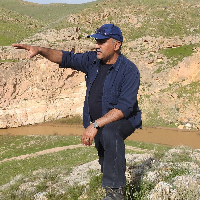Genetic Diversity of the Iranian Stripped hyaena (Hyaena hyaena Linnaeus, 1753), Using Mitochondrial ND2 Gene
Author(s):
Article Type:
Research/Original Article (دارای رتبه معتبر)
Abstract:
Striped hyena is the only member of Hyaena genus from Hyaenidae family in which lives in Iran. It belongs to the CARNIVORA order and Feliformia Super-family. In overall, our information about this species is little nationally and internationally. Therefore, basic information would be required to perform the informed protection action plan toward such valuable species. In present study, we evaluated the gene diversity within the hyena populations in Iran by reproducing a 404 base pairs from mitochondrial gene ND2. DNA was extracted from 30 muscle tissue samples of the Iranian Stripped hyena collected form road killed specimens in 12 different provinces. To determine the taxonomic status of the studied species, Mega 6 and Mr. Bayes 3.2 software were used to draw phylogenetic trees (i.e. Neighbor Joining, Minimum Evaluation and Maximum Likelihood models). The obtained results revealed that there are only 0.74 percent genetic distances between specimens and there is no significant gene diversity amongst the Iranian Stripped hyena populations. In addition, the obtained posterior probability over 90 percent for all specimens suggests that all studied specimens are belong to the same species. Although, observed low genetic diversity in Iranian Stripped hyena could be translated to the higher sensitivity of this species against environmental stresses. But, according to the fact that gene differential relatively could reduce by using short base sequence, using other mitochondrial genes as well as longer base sequences are suggested to obtained more clear picture from the Iranian Striped hyena genetic status
Keywords:
Language:
Persian
Published:
Taxonomy and Biosystematics, Volume:10 Issue: 3, 2018
Pages:
71 to 82
https://magiran.com/p2052556
سامانه نویسندگان
مقالات دیگری از این نویسنده (گان)
-
Evaluating the ability of Ca-Markov model to predict of the land use changes (Case study: Bijar protected area)
Mehdi Meratifar, , Jamil Amanollahi*
Geographic Space, -
Estimating the value of ecotourism and the status of education, environmental and socio-economic factors affecting it
Navid Zamani *, Javad Hatami, Seyd Mohamad Shobeiri,
Journal of Animal Environment,



